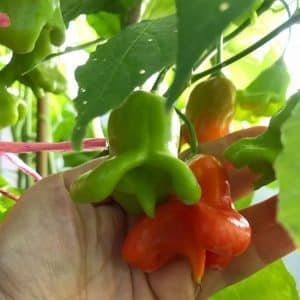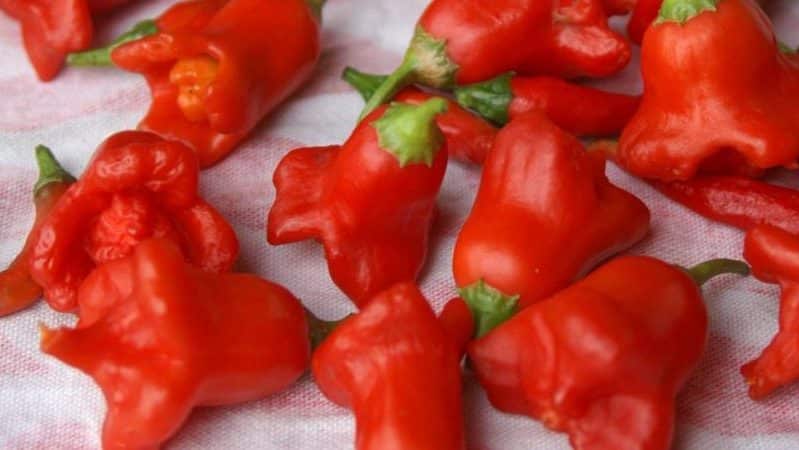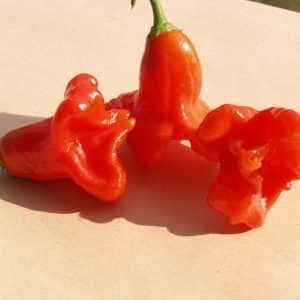Combining contrasting tastes and looking like a flower, the amazing Bell pepper variety
Today, no one is surprised by the variety of colors of peppers; the shape also varies. Bell pepper, belonging to the group of rare berry peppers, stands out among others varieties.
Read about its features, pros and cons in our article.
What type of pepper is this?
The Bell pepper variety differs from others in the interesting shape of its fruit, which resembles flower buds. This species is becoming increasingly popular in Russia, becoming an exotic decoration for garden plots.
Characteristics and description of the variety
Bellflower is a late-ripening variety.
This is a rather tall, up to 2 m tall, spreading plant, the leaves and stem of which are slightly covered with fluff. The fruits have an original shape: similar to a bell flower. At first they are dark green, a little later orange, and when fully ripe they become bright red.
From one Bluebell bush you can harvest about 2 kg of harvest. This variety of pepper can be grown in open ground, in a greenhouse or in a pot.

Distinctive features
The difference between this variety and others lies not only in the interesting appearance of its fruits, but also in its unusual taste combination. The part of the fruit near the tail is bitter, reminiscent of hot pepper, and below, where the fruit looks like a flower, its walls thicken and become sweet and sour in taste.
Fruit characteristics, yield
The fruits of this pepper are smooth and shiny. Their weight depends on growing conditions and reaches 70-90 g.The walls are fleshy, about 4 mm thick. Number of cameras - 2-3. Productivity is relatively high. The fruits reach maturity 130-140 days after planting the seeds. From 1 m² you can harvest 5 kg of fruit.
Preparation for cultivation
Preparing for growing the Bell variety is no different from other types of pepper. It is not fresh seeds that germinate better, but those that were collected 5 years ago. They begin to sow seedlings in February, checking the lunar calendar.
They start by soaking the seeds in Epin or Fitosporin. Sometimes they are pre-treated with a manganese solution. Then the seeds are wrapped in a wet cloth and plastic wrap and left in a warm place until the sprouts hatch.
The soil for planting is preheated to 20 °C.
Growing seedlings
Bell pepper does not tolerate picking, so it is better to sow the seeds immediately in separate cups. Nutrient soil with sand and peat is added to the seedling containers, watered with “Fitosporin” and the sprouted seeds are carefully laid out. Sprinkle 1.5-2 cm of soil on top, cover with a lid, and leave in a warm place. When sprouts appear, the trays are moved to a well-lit windowsill.
Attention! Protect seedlings from drafts, otherwise the plants may die.
Planting pepper
You can plant peppers in open ground when the threat of frost has passed and the ground has warmed up well. By that time, up to 12 leaves will appear on the seedling. The growing place should be well lit and sheltered from the wind. It is best if legumes, cabbage or cucumbers grew there the previous year.
Seedlings should be replanted in the evening or in cloudy weather. Bushes are planted at a distance of at least 45-50 cm from each other.
You need to add a handful of ash to the planting holes, and after planting, pour in a solution of manganese. The ground around the bushes can be mulched to protect it from weeds and drying out.
If the weather worsens, the plantings can be covered with film.
Further care
Subsequent care for Bell peppers is almost no different from other varieties. Here are some features:
- in bushes it is necessary to pinch the side shoots growing below the first ovary;
- water moderately and only with warm water so as not to stress the plants;
- Fertilize the Bluebell 3 times per season - 2 weeks after planting, add mullein diluted with water 1:10, during the flowering period, water it with a solution of wood ash, after 3 weeks add minerals (potassium, phosphorus and calcium);
- before flowering it is recommended to carry out treatment against pests;
- a month before harvesting, pinch all the shoots to allow the pepper to ripen;
- You can also harvest it green; such fruits are sweeter. The pungency appears in them as the color changes to red. This happens literally in a week.
Important! The variety is perennial; over time, the plant trunk becomes rough and covered with bark. As the temperature drops, the leaves fall off. For the winter, the pepper needs to be transplanted into a tub and moved to a warm room. With the arrival of spring, buds will appear on the Bluebell again.
Features of growing the variety and possible difficulties
Those wishing to grow Bell peppers may encounter some difficulties. The main one is that the seeds are rarely found on sale; it is better to look for them from gardeners who have already grown this variety.
Bushes can reach a height of 2 m, so the beds need to be equipped with supports so that stems that are not too strong can rest on them.
If you are planning a perennial crop, then you need to plant the seedlings in tubs with holes in the bottom. This will allow you to take the plants outside in the warm season, and with the first frost, take them into the warmth.
The variety is suitable for year-round fruiting if grown in a greenhouse.
Typical diseases and pests
Most frequent illnesses, affecting Bell pepper:
- Gray rot covers the leaves with gray spots. In advanced cases, the plant dies. In the initial stages of the infection, it is necessary to cut off the infected branches, and if the disease has spread to the entire bush, it is necessary to treat it with the Gamair fungicide (add 10 tablets per 10 liters of water).
- Anthracosis covers the plant with brown spots and leads to death. A 1% solution of Bordeaux mixture can help in the fight against this disease. Prevention is done by regular loosening of the soil.
- Blackleg - a disease caused by a fungus and leading to blackening of the stem. Fitosporin-M is used for treatment.
Bell pepper is recognized as the most common pest of peppers. aphid. If the plant is affected by this insect, immediately prepare the following solution:
- Brew 10 g of ground pepper and 200 g of tobacco with boiling water and pour into a 10-liter bucket of water;
- rub some laundry soap there;
- spray the bush and the soil around with the resulting solution.
If the pepper is attacked by the Colorado potato beetle, celandine will help. Beans planted nearby repel these insects.
An infusion of several bulbs and heads of garlic, kept for a week in a bucket of water, is effective against spider mites. The resulting liquid is sprayed onto the pepper bushes.
Advantages and disadvantages of the variety

The advantages of this spicy pepper variety are as follows:
- perennial;
- can be grown in soil and in pots;
- high yield;
- can be eaten raw and after heat treatment;
- contains B vitamins, vitamin C and serotonin - the hormone of joy.
The disadvantage is the long period of fruit ripening - about 5 months.
Attention! Fresh bell pepper fruits are recommended to be consumed with caution by people who have problems with the gastrointestinal tract.
Application of fruits
Due to its extraordinary taste, Bell pepper is eaten both fresh and canned. It can be stewed, stuffed, added to salads and sauces, and used to decorate dishes.
The unusual shape of the fruit will decorate any vegetable garden. marinades-assorted
Reviews
We bring to your attention several reviews from summer residents about this variety.
Evelina, Krasnodar: «The taste is undoubtedly interesting, but I didn’t notice any strong spiciness. The flesh is rather sweet-spicy. All the heat is in the seeds. But the kitchen was pleasantly enlivened when the fruits were ripe.”
Sviridova V., Tula: “On the Internet I came across a description and photo of this variety. I started looking for seeds in stores and couldn’t find them. I had to order from the online store. Of the 15 seeds, 12 sprouted, so I distributed them to friends myself. Pepper bushes are beautiful both during the flowering period and when the fruits are set. Pepper is good fresh or pickled.”
Read also:
How to salt whole bell peppers for the winter quickly and tasty.
Conclusion
Bell pepper is still unusual for Russian gardeners. However, summer residents who are already growing this variety in their garden plots note its bright and elegant appearance, the absence of any particular difficulties in care, high yield and the piquant, sharp-sweet taste of the fruit.Some difficulty, according to farmers, is finding the seeds of this pepper.